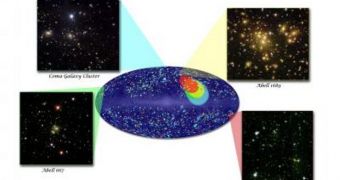When peering at the night sky through any telescope, the stars appear to be still. In fact, they've maintained the same relative position towards Earth since mankind started taking an interest in them. But astronomers have recently detected that a number of clusters of galaxies travel through the Universe along a certain path at incredibly large speed, of up to several million miles per hour. This outpour of galaxies has been dubbed the dark flow, and astrophysicists have been fascinated with it because the current models of how matter is distributed in the Universe cannot account for it.
Experts at the NASA Goddard Space Flight Center (GSFC), in Greenbelt, Maryland, have determined that this flow is centered around our solar system, on one end, while the other end of the axis is oriented towards the southern constellations of Centaurus and Hydra. The new investigation was unable to determine if the clusters are coming or going, but their motion was unequivocally recorded. The research was led by GSFC expert Alexander Kashlinsky. The collective motion of the celestial structures was observed for twice the distance preciously noticed in other investigations. “This is not something we set out to find, but we cannot make it go away. Now we see that it persists to much greater distances – as far as 2.5 billion light-years away,” the team leader says.
The thing about this dark flow, in addition to the fact that current models cannot account for it, is that it calls for external forces, outside the horizon of our Universe, to be pulling on matter from certain directions. Therefore, the idea has been very controversial. “We detect motion along this axis, but right now our data cannot state as strongly as we'd like whether the clusters are coming or going,” the GSFC expert adds. In other circumstances, astrophysicists would turn to the Cosmic Microwave Background (CMB), the fossilized light radiation left behind from the Big Bang. But, as it stands, X-rays emitted from the center of galaxy clusters scatter these microwave photons, making the use of CMB reference frames a scientific impossibility.
“It takes, on average, about an hour of telescope time to measure the distance to each cluster we work with, not to mention the years required to find these systems in the first place. This is a project requiring considerable followthrough,” explains University of Hawaii professor Harald Ebeling. He is part of the team that applied three-year WMAP data releases to a cluster of about 700 galaxies in 2008, to observe the dark flow. As the WMAP and the European Space Agency's (ESA) Planck telescope send more data on the CMB, the experts will compare it with more and more galaxies. Details of the investigation appear in the March 20 issue of The Astrophysical Journal Letters.

 14 DAY TRIAL //
14 DAY TRIAL //